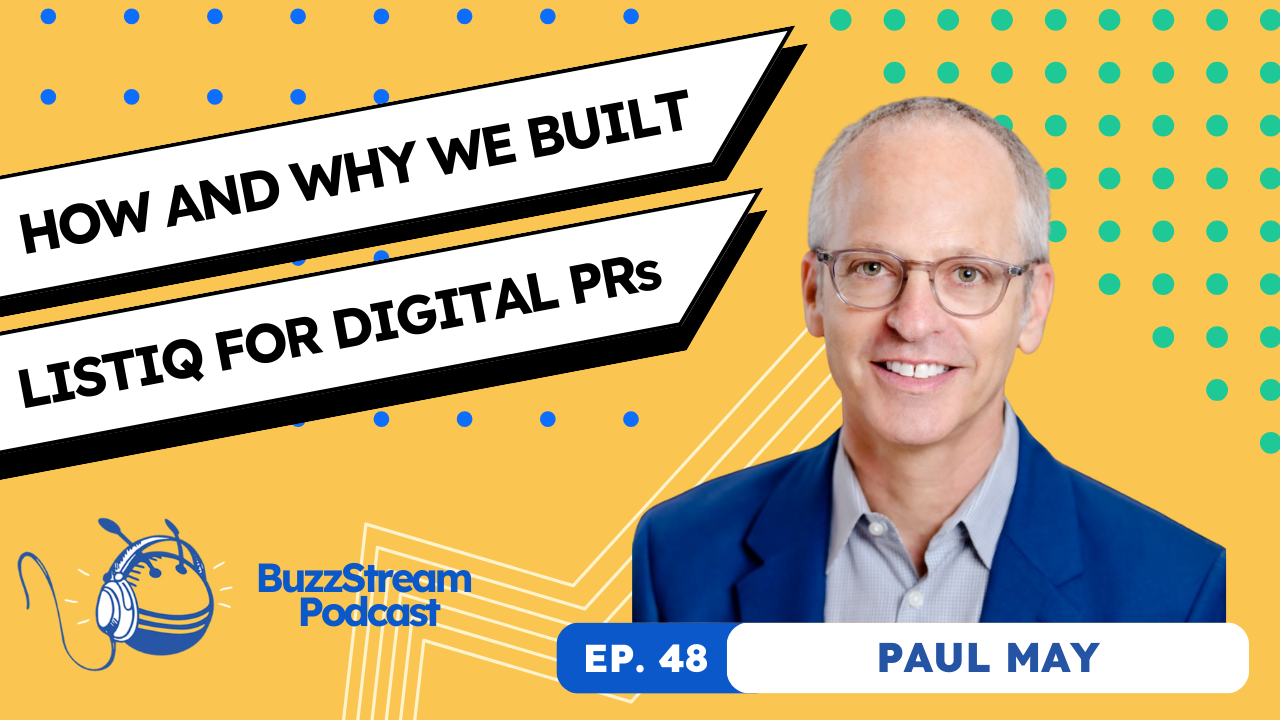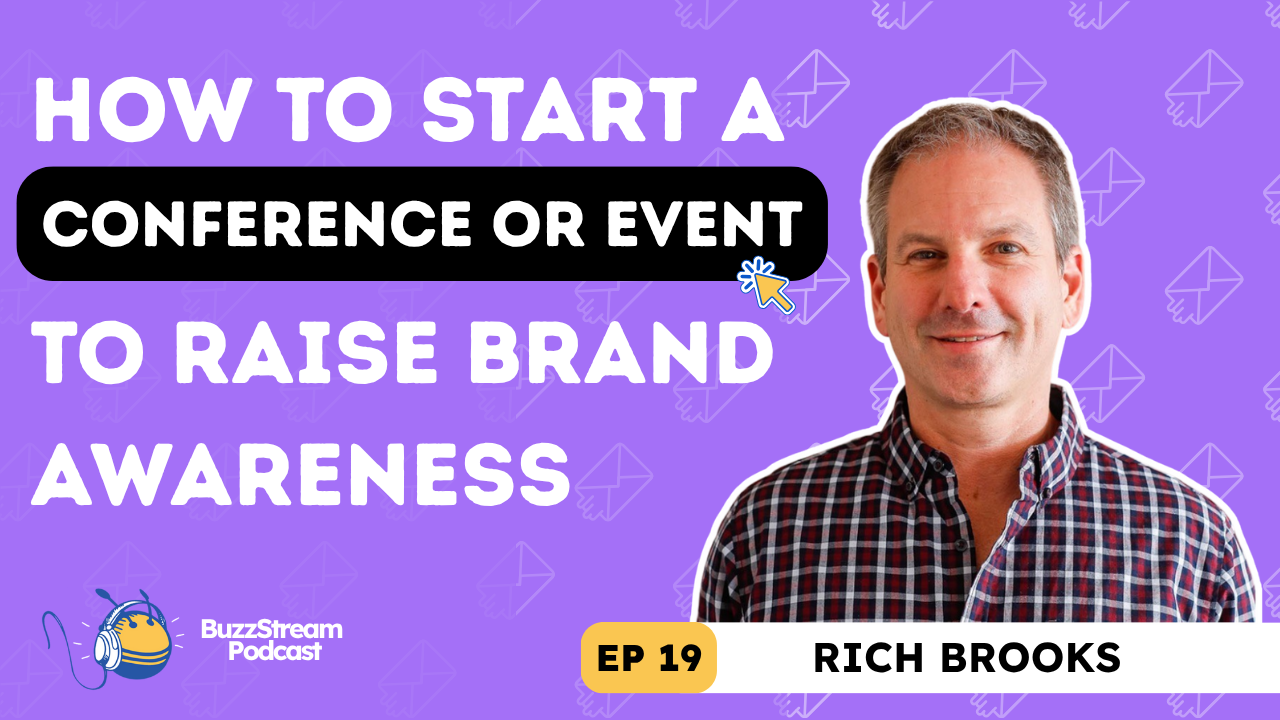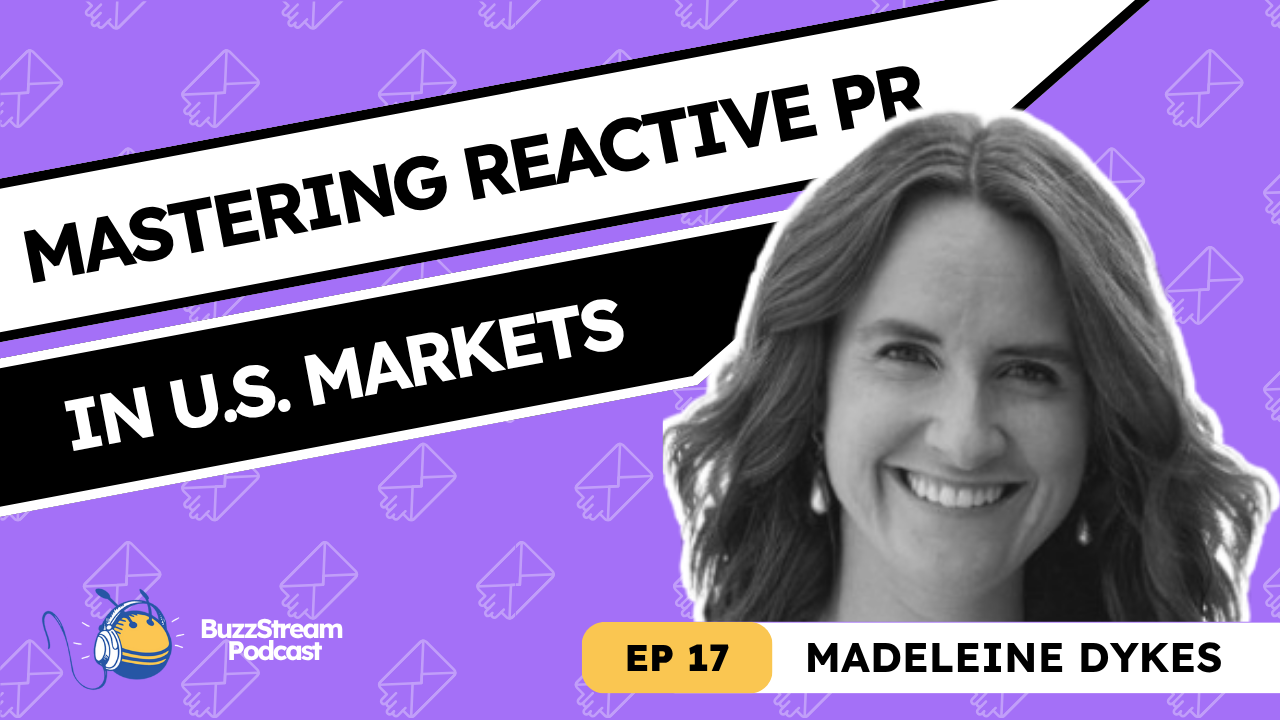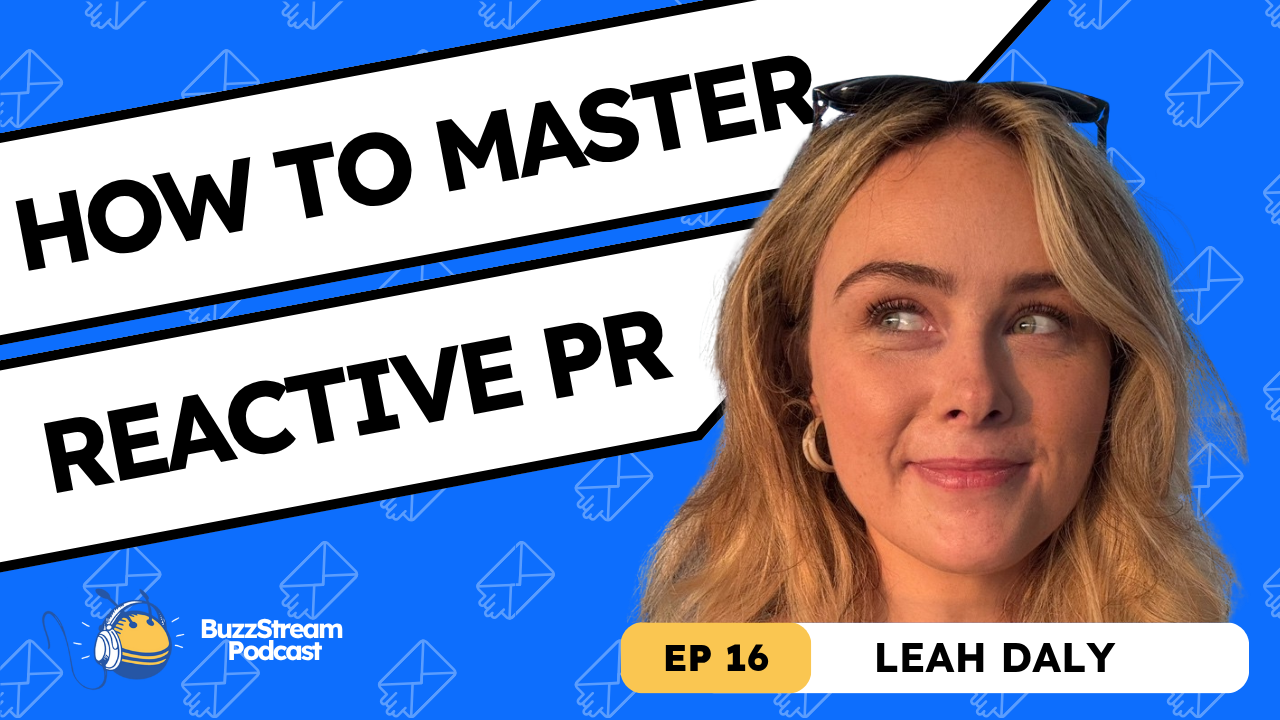Table of Contents
It’s been an exciting time here at BuzzStream since we’ve launched our new media list building tool, ListIQ.
So, I thought it would be helpful to get the full story from our CEO, Paul May on why we built the tool, what problems it solves for digital PRs today, and what the future holds for ListIQ.
Enjoy!
- List IQ is an AI-powered tool for building targeted media lists.
- Traditional outreach methods are often too manual and untargeted.
- Building relationships with journalists is crucial for a successful PR strategy.
- The digital PR landscape is becoming increasingly competitive.
- Many existing media databases provide outdated or inaccurate information.
- List IQ aims to provide real-time, accurate journalist profiles.
- The tool will integrate seamlessly with BuzzStream’s CRM.
- Future capabilities will include finding relevant articles for pitches and much more.

Why did we decide to launch List IQ?
Paul May
Yeah, I mean, it fits in with what our goal of the company has been since really we started. So the goal of BuzzStream really was to give people the tools, the workflows and the data that they need to conduct really highly targeted, highly relevant, highly personalized outreach, but do it at a scale that would move the detail of the business. It’s why we started BuzzStream. That’s why we launched the CRM and the outreach tools. And we’re proud of that. But frankly, the reality up until now,
that the tools could only take you so far. And so all of the steps, if you look at PR and outreach, are just still too manual and too untargeted. You take it from the list building, the writing the templates for each angle, customizing each email, even coverage reporting, it’s just way too manual and not targeted. And if you look at list building particularly, if you want a hyper-targeted list, you generally can’t
get that from the media databases. So you’ve got to go do hand research on each contact. And most of the time people just don’t do it because it’s just too time consuming. And you can even see that in the research you’ve done on the impact of it on coverage rates and what we see most people doing as far as the size of their list where we’re doing it. It’s just not really happening. And so when we started work.
Vince Nero
Yeah, Paul, can interrupt you here, but to give some color to that, like for people who haven’t seen it, we, I’ve recently kind of got access to the Buzz Stream user data. So I’ve been able to dive into this stuff. It’s been really exciting to see and find some of these insights and
I mean, what it’s doing is really backing up some of the stuff that we’ve kind of felt that, you know, in our gut, but, to, to elaborate on what Paul was saying, like we saw, we found, reply rates drop almost like three times as the campaign scales from like, campaign size from like one to 50 response. then it’s sorry, from one to 50, recipients. like,
And you just kind of see it dip as you get larger and larger and you know, the one hand, it’s like, okay, well, does that just mean we should send fewer emails? Well, no, like the takeaway here is these people that are doing this, like as I dig into it, as we talk to our customers and people that use.
BuzzStream for digital PR, we find that what they’re doing is just building these highly personalized lists, highly targeted. They’re not necessarily using the media database as a crutch as much as some of the other agencies out there.
Paul May – And it’s not like people don’t know that they’re not that they’re going to get much better results if they don’t, you know, really hyper target. It’s the can’t, you know, it’s just too time consuming. And we heard this over and over again. It’s like people would say, well, I go into whatever media database I’m using and I just use these keywords and I get a list and then I blast it to 200. Um, and then I sent a list of maybe 10 to 20 to ones that I found, you know, kind of hand curated.
And I get as good of results from those 10 to 20 I said just the full 200 but they just don’t have the time to build more of list out so and when we started working with generative AI so we saw this problem and then we started working with generative AI and the light bulb just really turned on for all of us it was like fun yeah go ahead
Vince Nero – Yeah, tell me, because you’ve been digging into this a long time. I mean, there were, you we have these weekly scrums and you were sharing, you know, initial findings. I’m doing a deep dive into this to figure out how this works.
And I feel like you kind of really set up the framework early on, but, you I remember you talking about how people were missing something when they talked about AI.
What are people missing from AI tools?
Paul May
Yeah, I mean, well, there’s this thing. I mean, we saw right away and a lot of people saw this, that even when we were looking at GPT-3, which is a pretty dumb model,
We knew that if we gave it the right training, the right data and the guardrails, it could do a lot of the manual, painful work that’s part of the outreach process. The part that I think you’re getting at when I thought that a lot of people were getting it wrong and, you know, a lot of people still kind of got it, but people would talk about how many mistakes it would make and how it just wasn’t very smart.
And I just didn’t and I still don’t really think that matters that much you don’t need perfection in these models You don’t even need that much intelligence. Like if you look at you just needed to do the work for you So, you know think about how many people utilize? VAs or interns to go and do research for them and they’ll just go out there and just go and look at the you know, the each journalist or each prospect one by one.
And it’s just very manual and and it’s not it’s not super intelligence work You don’t need to be super intelligent to go do that. You just need to do the work and When I looked at generative AI what I immediately thought of is what if I had an unlimited number at the least what if I just had an unlimited number of VAs or Interns who could go research every single prospect every single journalist and build a detailed profile for each one of them as though they had unlimited time to do it for each one.
That’s what you could get.
And so you don’t need super intelligence.
You just need the right training, data, you need to give the right information, and you need to set guardrails in place so it doesn’t make the mistakes that could be problematic. The other reason why I think it mattered that much was because any model you’re working with that moment is the dumbest it’s ever going to be.
It just keeps getting smarter and smarter and smarter. So even if it was not able to do a certain capability today, there are things that we are working on right now, now that we’ve delivered the first version of List IQ, that we could not do two months ago. So it’s just changing dramatically with the deep research capabilities, with the reasoning capabilities. It’s just getting more more powerful all the time.
Vince Nero – I have some questions, I think, about the future that I think people will be interested in hearing. I like the future plans, but I do want to before we do that kind of make sure we drill down kind of the thought process of the problems that we were solving or the problems that we saw in the industry that list IQ is really solving.
Cause I think it kind of gets down to, you know, two or three major issues that this tool as it stands right now is really targeting. So I’d love to hear you talk about that a little bit.
What are some of the major problems in the industry that this tool solves?
Paul May – So we’ve covered a little bit of it, but just to drill into that thing, the two ways that people build lists, one, they go to their media database, build a big broad list. They try to make it more relevant and they do an okay with it. But they’re not very targeted. And you get issues like an example that one PR person gave me, more of traditional PR person, said, I have to go look at, they were doing outreach on behalf of a drug company. And they said, well,
Yeah, I can go look and see if somebody has written about my competitor. Let’s just make up Pfizer. But I’ve got to go make sure they didn’t write Pfizer is once again finding a way to stick it to the American consumer, right? So the fact they wrote about Pfizer is not, yeah, it’s relevant, but I need to understand what’s the context, those types of things.
So at best, you can use a media database, pull a list, and then send to it. But as we’ve seen, the coverage rates tend to be very low. You tend to send emails that are going to hurt your reputation with the journalists, which is, we’ll talk about, is going to get more and more important.
That approach and then other approach we see a lot of people doing is they’ll go use Google News, they’ll do manual searches, they’ll look at through the SERP, search engine results page, look at which ones look potentially interesting, they’ll go to the actual page, they’ll read the article, then they’ll look for the email address, they’ll see what else they’ve written on the author page and it’s just really, really time consuming. So people either do it in these small batches or don’t do it at all. And so, you know, in the best case,
when we did all our customer interviews, people were sending these lists, like I said, to most of, know, 90 % to the media database contacts, 10 % to the ones they manually pulled, and they were getting as good or better coverage from those small lists from the big ones. And our thesis has been that this is only going to get more and more important because the growing importance of digital PR as we get more AI search and things like that.
We’ve seen this with the recent Google I.O. hubbub.
So we think that’s going to explode.
And on top of that, you’ve got the fact that there’s fewer and fewer journalists to pitch. So you better stand out in the inbox or they’re just never going to get you. You need to become a trusted resource. So yeah.
Vince Nero –
Yeah, I mean, you touched on a lot there. I wanted to back up, give a big data point. We did our big state of digital PR report. And one of the things that we saw
We asked straight up, like, what are some of the problems people have with their media list building tools? And the main gripe was that they’re outdated or the info is just incorrect. you know, and we did a subsequent one to talking about like email finder tools. I mean, that is one way some people kind of get around some of this.
Well, you know, I’m building manual tools, but I’m going to, you know, finding the emails is tough. And so I’ve been using this tool and they’re built for sales outreach and you know, they’re good for some applications for sure. use them. Um, but for finding journalists, they just don’t work. And like, you know, again, the research found it was something like 60 % were either completely wrong or it said that, uh, it didn’t, couldn’t find it, but it could be found. Um, so
You know, all that’s to say there are a lot of problems. There’s this data behind it. And now we’re getting pushed into this area of Google, Google AI mode, you know, chat, GPT users are using different search, platforms. They’re searching in a different way. And I think that’s kind of causing a lot of C, SEOs to start looking at.
you know, okay, how do I get into AI overviews? How do I get into chat GPTs? And a lot of the early data that’s coming out is showing brand mentions and you know, less of the traditional link metrics are important and more of like the brand, Brandon mentions that even unlinked stuff is really important. So again, I think this is kind of like a fortuitous time to be, you know, pushing into the digital PR space for any agency because it just seems to be where the industry is moving.
Paul May –
One thing that jumps out at me about what you just said, Vince, is, yeah, I think that if I had to just guess the two things that, if I had to predict the two things that are guaranteed to happen over the next six months, one of them is that,
the amount of attempts to game the system is just gonna be, it is just gonna be bonkers for a bit. I mean, it’s not that different than the early days of SEO when everybody had their different little link wheel, social profiles, every little thing they could do. But that, yeah.
Vince Nero –
Yeah all the tricks and black hat stuff!
Paul May –
All the tricks. So that’s the one thing. The other thing that I guarantee you is just about everybody is going to add digital PR to their website as one of the services that they offer. And that’s just going to like, you’re going to be competing in the inbox against a lot of people, some who know what they’re doing and some who don’t.
You know, we’ve seen one company that you’re very familiar with, given your heritage, Siege, you know, we saw them a year ago talk about how they’re basically giving up on outreach and now they’re back talking about the importance and the value of digital PR in a huge way.
And I think there’s just a lot of thought leaders in the industry who are going to be pushing that. That’s going to drive things. So I think that it’s really important, but it’s going to become even more important to do it really well.
Vince Nero –
Yeah, yeah, the more competition for sure. And I think you touched on something else too that I wanted to elaborate on just kind of knowing, you know, firsthand basis. It’s like this idea of building a relationship with a journalist. You know people say that I feel like it’s an obvious thing to say or you want to build relationships.
Still, I think the thing that they kind of miss out on is this idea that like it’s not necessarily like the that building relationships is good it’s how much of a disadvantage you put yourself at if you are doing this kind of spray and pray outreach where you’re not reaching out to relevant journalists because they will easily block you, know, ignore you. mean, the advantages that you can have by…pitching just a relevant piece of content to a journalist.
I mean, it pays dividends.
It can get to the point and I haven’t felt this firsthand, but I don’t do a ton of expert commentary pitching.
However, I’ve heard that once you establish yourself as a trusted source, you don’t even need to pitch. They will reach out to you, you know, so I mean, that’s where the building relationships again, like I feel like that term kind of feels fluffy to some people, but I mean, it really does have some big benefits.
Paul May –
Yeah, I think that, I think people hear the word relationships and they, like you said, they kind of balk at that like these journalists are too busy.
They don’t care if you know their birthday or their dog’s name or their daughter’s birthday or whatever.
And that’s not really what we’re talking about.
What we’re talking about is they know that if they see your name in the inbox, that you’re not somebody who wastes their time.
That’s the kind of relationship. And some of those may end up being kind of like personal, friendly, whatever, but some of them just may be, Vince pitches me and I know I should read it because he’s not a time waster. That’s to me what we mean when we talk about that.
Vince Nero
Yeah. And look, I mean, you alluded to this too earlier. It’s like, a few days ago, I think it was even Business Insider laid off like 20 % of their staff. I mean, we’re seeing journalists getting laid off as more AI. Sorry, as AI continues to take market share away or traffic from some of these publishers. I feel like you’re going to keep seeing this.
So again, to your point, it’s just going to get more competitive than the level of pitching that you need to hit, it’s a higher bar for sure.
So I want to get into kind of why we structured these releases and the product in the way that we did, because these are some questions I had. We talked a lot internally about like how we should be doing this and you know my feeling as a practitioner in my previous experience with this stuff.
So, you know, we decided to kind of go list building first. Can you explain the thought process as to why that came first?
Why did you focus on list building for the main feature of this tool?
Paul May
Sure. The reason why we went, well, let me, the reason we went with list building first is because it’s foundational to everything else. And I’ll even go a step beyond it. There’s that reason. And then we said, well, let’s bite off this piece of list building, i.e. you give me an article and…the AI will go out and find information about the publication of it, about that journalist. And we picked that first because if we could do that well, it becomes a foundation for everything else. Whether that becomes, you get a good list, then you can write emails that resonate with the people. You can determine, you know, make sure that you’re hitting them with the right angle.
And this is again, as we talked about, because of things like AI search, it’s just gonna make it more more relevant.
So now that we’ve added that ability to either augment a Google News Search or just augment a set of URLs with the journalist and publication information. The next thing we’ll start doing, we’ll just keep working to take about big chunks of the work that people have for hyper-targeting.
So for example, we can, you know, now that we can augment those URLs, we can go a step before that and say, okay, give me information about your campaign, maybe give me a content brief, give me a press release.
Whatever it might be.
And you just give us that and we’ll say, hey, of the URLs that we go and find, we’ll go find URLs for you, we’ll run the searches.
These are the ones that are relevant and that are likely to be interested in it, likely to be receptive. So we’ll also do things like we’ll say, okay, you have a data study piece. Is this journalist
Do they cover data studies? Are they receptive to data study pitches? Things like that. We’ll also do things like integrated into BuzzStream and then from there do more and more to tie it into the actual outreach.
You start with that, build information about the journalists and the publications, go back a step and do things like determine if they’re relevant and receptive to what your pitch is, and then move forward and say, all right, this is what we know about these people. Give me information I can use to personalize this campaign to them. Make it relevant to what they care about.
Vince Nero
Yeah, I mean, I am really excited about the future of this thing. Paul I wanted to get into just a couple quick questions, you know, it’s in beta. We’ve been in beta for a week now I think we lot lunch at last Tuesday. So we’ve had a couple questions from users is List IQ a media database.
How do you kind of define it. Where’s the line?
Is ListIQ a Media Database?
Paul May
No, there is no database. Generally speaking, it’s building profiles in real time. Now there is some, we store some data that we can and that AI knows is safe to store. But generally speaking, anytime you hit that button, you’re getting an up-to-date list. So you’re getting the most up-to-date information every time you click the button.
Vince Nero
Yeah. Yeah. okay. Where do we get email addresses from? This is another big one. How accurate is the data? You know, I, I referred to that study that we did on email finder tools. I think somebody just straight up asked us like, what, know, is it, isn’t this just the email finder tool? How’s it different? Paul.
How do you get accurate data and how is this different from an email finder tool?
So let’s start with the accuracy data, accuracy information first, because that’s the easiest one to answer. As far as comparing it to tools that are on the market, I would compare it to two different areas.
One are the products that are focused on email finding, know, the hunters, the snow, all of us want rocket reach, et cetera. Those products are great for sales. They are not good at all for journalists. We are dramatically better than them.
We actually, when we first started building the tool, we were planning on leveraging their data to as an underlying technology to enable it. And what we clearly quickly found out is that it just doesn’t work. just doesn’t understand the nature of all of the consolidation happening in the journalism industry and all of problems.
So, dramatically better than them.
As far as media databases, in our testing against a data set of thousands of journalists, it’s doing as good or better than all of the media databases that, lists from media databases that we tested against. So I feel very, very confident about the way the accuracy of the data.
How it works? Complicated. But to make it simple, I’d say it does the research in the way that an experienced, very smart PR person would do it if they did it manually.
It leverages an understanding of the journalism industry. It knows that It knows a lot of things.
I’ll just just an example. It knows that if I’m reaching out to People magazine that I think this is right. I think it’s part of dot-dash meredith
and that the email domains for dot dash meredith generally speaking, are not people.com. Or it could be, but it’s leveraging rules to go be smart about the way it finds information.
And then we go and validate the emails using tools that are out there in the industry. And then in some cases, we leverage internal data to basically supplement this. So that’s a high level kind of explanation of how we go about that.
Vince Nero
Yeah, we don’t want to give away too much of the back end there, but yeah, think the takeaway for me was that yes, like…that this is real information. not just guessing like some of these getting off the email finder tools kind of do pattern matching.
And it was kind of an aha moment for me too with Paul’s example here of, you know, the dot dash Meredith.
You know, there’s plenty other all the people reach PLC, for instance, you know, they all have reach PLC email addresses.
So that’s something a tool wouldn’t be able to necessarily uncover.
What can people do if the tool finds a wrong email address?
Paul May
We will be adding a capability that you’ll see in lot of the media database companies where if you get the wrong one, you can tell them that it will fix it. That is, I talked about it in some cases, it’ll store data. That’s an example of it. It’s not in there yet, but that’s something we’ll be adding.
Vince Nero
Okay, next question would be is this part of BuzzStream CRM? How do the two kind of play off one another?
Is ListIQ part of BuzzStream?
Paul May
So today they’re totally separate products. We will keep them as separate products. So for people who are not Buzz Stream customers and just want to build lists, that will still be available. We will integrate it into BuzzStream much more closely. Today it’s a pretty easy import, but we’ll go the next step and give you the ability to just run those directly from within BuzzStream. As far as like packaging and pricing, we will provide BuzzStream right now it’s free, we’re in beta. When we have a better understanding what our prices
pricing should look like. We will also include some List IQ credits to BuzzStream CRM customers. Pricing is to be determined.
Vince Nero
Awesome. And then the last question is, will the AI be able to find relevant articles? You kind of mentioned this in the roadmap, but yeah, help me understand where the relevant articles for journalists.
Will ListIQ be able to find relevant articles?
Paul May
Yes. Yes. We are working on that as we speak. So some of the things that the team is working on, one is starting to do the relevancy checks. The first one, I mentioned data studies with a lot of customers who do data studies. So we’re doing a specific prompt and formula to go and check to see if somebody would be interested in data studies.
You can imagine that also, where we’ll take that is also to be doing the searches to find people who are interested in the data studies or who have covered the data studies in the areas that you are interested in. So yes, it will be able to do that hopefully soon. We’ll have more information about the roadmap soon.
Vince Nero
Yeah, and look, from my perspective, it’s the I’ve run this, you know, I’ve been testing it for months as well. And I think, you know, with a couple search operators, you can get pretty close to that anyway in Google News.
So, yeah, I mean, if people have questions about that kind of stuff, I’ll be publishing things, you know, look at my LinkedIn, but feel free to comment, DM me or anything with, you know, questions about this kind of stuff. I’m happy to help you become a power user of list IQ in the early stage.
Paul, this has been super helpful.
Great to talk about this stuff. It’s been an exciting week for us. So people can find you on LinkedIn; I know you’re active there.
And like I said, if people have questions about any of this stuff, Paul’s DMs are open. My DMs are open.

 End-to-end outreach workflow
End-to-end outreach workflow



 Check out the BuzzStream Podcast
Check out the BuzzStream Podcast







